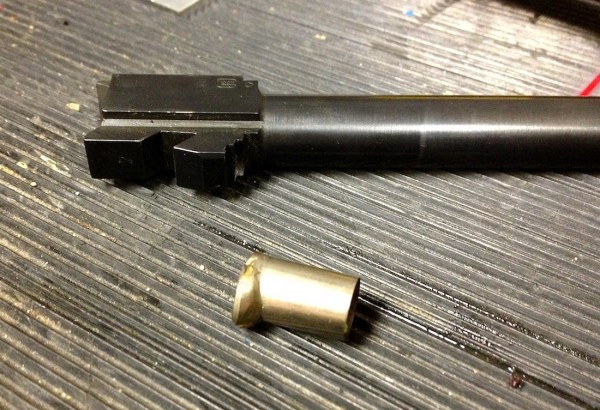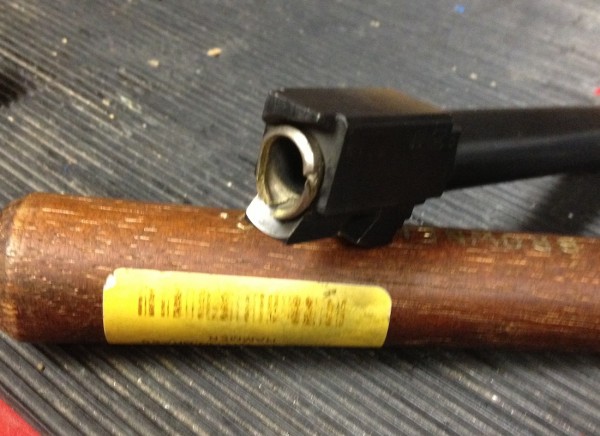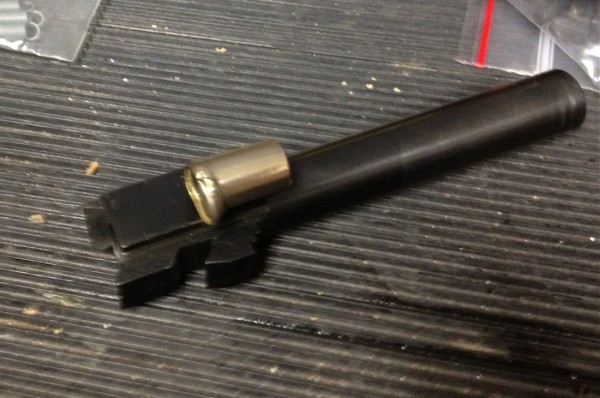It should not be a surprise to anyone that it is difficult to get consistent supplies of ammunition these days. Unfortunately, that means that the quality of what is being fed into our guns might be a bit (lot) lower than it has been for a while.
It has been several years since I’ve worked on a pistol that suffered a ka-boom. Last month, a personally owned Gen 3 Glock 22 came across my bench at work after one of those events. The owner had been firing frangible rounds from a commercial reloader. I ended up having to replace the internals in the slide.
The case head wasn’t recovered, and there was a tear in the case at 3 o’clock – where the extractor claw would be – and the case has blown out to match the shape of the feed ramp.
Just a reminder, even when ammunition is scarce, take a second or two and consider what you are feeding your firearm. New? Re-manufactured with once fired brass? Or have the cases cycled through the reloader several times?
(I apologize for the photo quality.)






These things seem to be much more frequent now than years ago and some people will disparage the gun involved when the same thing would happen regardless of what gun is involved- bad ammo is bad ammo. I disagree this has anything to do with glocks as so many are fond of saying.
This is not so much a “reloaded” ammunition issue as it is a shooter and Glock 22 issue.
Consideration #1:
All Glock 40SW chambers are unsupported. In other words the 6 o’clock position of the chambered round is not supported by the barrel or anything else for that matter. Hence, the infamous Glock bulge in 40SW once fired brass.
Consideration #2:
Only reload ONCE fired 40SW brass from know sources/vendors. If you are shooting re-manufactured ammo (reloaded ammo by a FFL Type 07) BEWARE!
Ammo discharged in a Glock 40SW barrel WILL be subject to greater expansion (Glock bulge) then in a supported barrel/chamber. During resizing, brass is resized to a greater extent thus inducing the likllihood of fatigue failure earlier than in brass fired from a supported chamber.
The failure of the rim in this article is a CLASSIC example of brass failure in reload/remanufactured ammunition once (or repeatedly) discharged in a Glock 40SW barrel.
In 40+ years of reloading, I have had ONE failure; in a Glock 27. When the failure occurred, the case failed as depicted in the article’s picture. The extractor flew into the woods and I was a bit surprised. After examining the brass, it dawned on me that the brass was not a piece of brass I source nor did it have my identifying marks. I mark the the headstamp to ensure that I collect my brass, and only my brass at the range. If I can not ID the brass as mine, I toss it.
Some how (well I know how, but, we will not go there since she is sitting across the dinner table from me) this unknown brass made it through 3 inspections into my brass reloading bin (bad on me). I subsequently inspected ~3K+ rounds of reloaded 40SW and discovered 4 more pieces of this identical brass I had reloaded. I downloaded the ammo and destroyed the brass.
Reloading is very safe and economical IF you adhere to all the variables involved; and particularly, where you source your brass.
There are horror stories related to 556 brass. One can not reload 556 brass that has been discharged in a SAW. Over expansion of the brass due to very loose chamber specs, followed by resizing and reloading for your AR is a recipe for a disaster due to over-working (fatigue) the brass during the resizing process.
I can’t begin to count the USPSA and IDPA events I’ve participated and witnessed dudes with brass collectors pick up every piece of brass they can find. You are asking for a significant failure if you do this; especially with 40SW brass ejected from a Glock.
There are all kind of gizmos available to reduce/remove the Glock bulge from 40SW brass. But, the bulge is not the problem, over-working the brass during resizing is the issue. Resizing alters the crystallization matrix of the brass making it weaker and subject to failure.
Consideration #3:
If you shoot/reload 40SW in/for a Glock, buy factory ammo! Mark the headstamp with a unique colored Sharpie for identifying the brass as yours when you pick it up. And, only reload your brass! And most importantly, sort your Glock 40SW brass by the number of times you have reloaded the brass. After the 4th reload/discharge, I destroy the brass by smashing with a hammer. I have no scientific evidence the 4th reload is the magic number. It simply works for me!
Controlling ALL of the variables during the reloading process is the only way to prevent a failure that might result in your, or a bystanders injury, or worse.
Be safe! Reloading is a safe, enjoyable and money saving venture IF you are mindful of all the variables that can go wrong.
I was unsure on whether or not to reload my glock 22 brass, because of the support issues. Now I’ll see how long it takes before the brass swell becomes excessive. Btw does anyone know if the case is fully supported in an M&P?
I would not even consider reloading brass or chambering a reloaded/remanufactured 40SW round that did not have the “Glock bulge” removed prior to or during resizing!
Bulging brass is an OUT OF SPEC component. I have never tried, but, I seriously doubt you will get a bulging brass, reloaded 40SW rounds to pass a case gauge check.
EVERY round I reload will pass through the case gauge and at the same time I check for a “proud” primer. The reloader’s job is not complete when that round falls off the press and into the bin. It takes additional time, but, as mentioned in the above post, to ensure the highest margin of safety, YOU must control EVERY variable during the reloading process.
Billy – Just a note based on observations at my Office, watching a few hundred .40SW Glocks (of various models) in service over the years.
Years back, when we shot a lot of reloaded .40SW I saw the issues mentioned more than a few times. I can’t recall seeing any more once we switched to almost exclusively factory loaded ammunition (frangible) for training.
Not arguing that there are not more than one causal factor present. My intent was to remind people about considerations with reloaded ammunition.
Thank you for reading the article, I appreciate your feedback.
Erik
My apologies if I implied a problem with factory NEW ammunition. I did not mean to imply that there is a problem with factory ammunition in Glocks. Not the case at all. Likewise, I have never seen an issue with factory FIRST ammunition. And I’ve run with some guys who are provided training ammunition by the 55 gallon blue poly drums.
I meant to only assert that for the amateur reloader of 40SW for their Glock, it is critically important to have a trusted source of “once fired” brass (is it really “once fired”?) if not shooting factory new brass and then reloading. Further, it is very important to carefully track the number of times discharged Glock 40S&W brass is reloaded. Destroy the brass after so many reloads. Determine a number that works for you. My choice is 4 resizing events, or 3 reloads, and then I destroy the brass.
Once can not reload Glock 40S&W (discharged) brass an indefinite number of times. At some point, the brass will fail during discharge as depicted in the picture due to fatigue.
I should also note, I am not implying there is a problem with the design of Glock 40 S&W chambers. Not the case at all. This issue being discussed is a reloading variable that must be addressed by reloader.
My fingers were moving too fast for my brain and eyes….
…3 resizing events resulting in 3 reloads…
If you guys ever need another option.. The guys over at http://www.diamondkbrass.com/ are great.